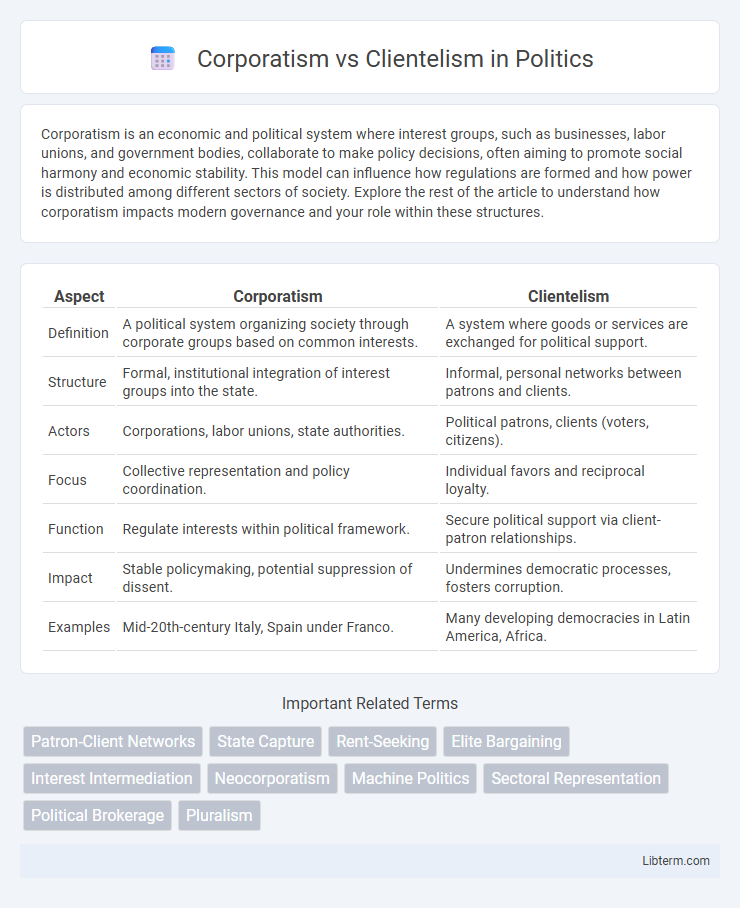Corporatism is an economic and political system where interest groups, such as businesses, labor unions, and government bodies, collaborate to make policy decisions, often aiming to promote social harmony and economic stability. This model can influence how regulations are formed and how power is distributed among different sectors of society. Explore the rest of the article to understand how corporatism impacts modern governance and your role within these structures.
Table of Comparison
| Aspect | Corporatism | Clientelism |
|---|---|---|
| Definition | A political system organizing society through corporate groups based on common interests. | A system where goods or services are exchanged for political support. |
| Structure | Formal, institutional integration of interest groups into the state. | Informal, personal networks between patrons and clients. |
| Actors | Corporations, labor unions, state authorities. | Political patrons, clients (voters, citizens). |
| Focus | Collective representation and policy coordination. | Individual favors and reciprocal loyalty. |
| Function | Regulate interests within political framework. | Secure political support via client-patron relationships. |
| Impact | Stable policymaking, potential suppression of dissent. | Undermines democratic processes, fosters corruption. |
| Examples | Mid-20th-century Italy, Spain under Franco. | Many developing democracies in Latin America, Africa. |
Understanding Corporatism: Definition and Key Features
Corporatism is a political and economic system characterized by the organization of society into corporate groups such as agricultural, labor, military, or scientific sectors that collectively negotiate with the state to influence policy. Key features include structured representation of interest groups, state mediation in social and economic interests, and a focus on collaboration between these groups to achieve socio-economic stability. Unlike clientelism, which relies on personal patronage networks, corporatism emphasizes formal institutions and collective bargaining.
What is Clientelism? Core Characteristics Explained
Clientelism is a political system where goods and services are exchanged for political support, often involving unequal relationships between patrons and clients. Core characteristics include personalized exchange, hierarchical relationships, and the reliance on patronage networks to secure loyalty and votes. This system often undermines institutional governance by promoting favoritism and reciprocity over merit and rule-based policies.
Historical Origins of Corporatism and Clientelism
Corporatism emerged in the late 19th and early 20th centuries as a political ideology advocating the organization of society by corporate groups such as agricultural, labor, and business sectors, with roots tracing back to medieval European guild systems. Clientelism, by contrast, has ancient origins across diverse civilizations, characterized by reciprocal relationships where patrons provide resources or protection to clients in exchange for political support. The historical evolution of corporatism is closely linked to institutional attempts at social harmony and economic coordination, whereas clientelism focuses on personalized, hierarchical exchanges that often undermine formal political structures.
Structural Differences: Corporatist vs. Clientelist Systems
Corporatist systems organize political and economic interests into structured, institutionalized groups that negotiate with the state through formal channels, emphasizing collective representation and policy coordination. In contrast, clientelist systems operate through personal, informal networks where political support is exchanged for material benefits, prioritizing individual or group loyalty over institutional processes. The structural difference lies in corporatism's reliance on regulated, collective bargaining mechanisms, whereas clientelism depends on patron-client relationships embedded in social hierarchies.
The Role of Institutions in Corporatism and Clientelism
Institutions in corporatism facilitate structured collaboration between the state, businesses, and labor groups, promoting policy stability and collective bargaining frameworks. In contrast, clientelism thrives on informal networks and personalized exchanges, where institutions often lack transparency and accountability, enabling patronage and favoritism. Effective institutional design in corporatism supports systematic interest representation, while clientelism undermines institutional impartiality by prioritizing individual loyalties over formal rules.
Impacts on Democracy and Governance
Corporatism structures interest representation through formal organizations integrated into the policy-making process, fostering stability and coordinated governance but risking exclusion of marginalized groups and entrenchment of elite interests. Clientelism relies on personal networks and patronage exchanges, undermining democratic accountability by prioritizing loyalty over merit and weakening institutional transparency. Both systems influence governance quality, with corporatism potentially enhancing policy coherence while clientelism often leads to corruption and weakened public trust.
Economic Consequences of Corporatist vs. Clientelist Approaches
Corporatism fosters economic stability by promoting structured cooperation between government, labor, and business sectors, resulting in coordinated wage policies and reduced labor conflicts. Clientelism often leads to economic inefficiencies by encouraging patronage and rent-seeking behavior, which can distort resource allocation and undermine public trust. Empirical studies demonstrate that corporatist economies typically exhibit higher growth rates and lower inflation compared to clientelist systems prone to corruption and market distortions.
Case Studies: Corporatism in Practice
Corporatism in practice is exemplified by countries like Germany, where structured cooperation between labor unions, employers, and the state facilitates policy negotiation and economic stability. The Swedish model showcases institutionalized corporatism through centralized wage bargaining and social welfare collaboration, resulting in low unemployment and equitable income distribution. In contrast to clientelism, these corporatist case studies emphasize organized interest representation and long-term social partnership over personalized, exchange-based political relationships.
Case Studies: Clientelism in Practice
Clientelism manifests in various political systems through the exchange of goods or services for electoral support, as seen in the Philippines where local politicians secure votes by providing direct material benefits to constituents. In Brazil, clientelistic networks often intertwine with social welfare programs, leveraging state resources to maintain political loyalty among marginalized communities. These case studies illustrate how clientelism undermines democratic accountability by fostering dependency and perpetuating unequal power relations within governance structures.
Challenges and Future Trends in Governance Models
Corporatism and clientelism face challenges such as transparency deficits, limited accountability, and entrenched power dynamics that hinder democratic governance. Future trends indicate a shift towards hybrid models incorporating digital platforms to enhance stakeholder engagement and reduce patronage-based networks. Innovations in governance aim to balance inclusive representation with efficiency, addressing systemic corruption and fostering sustainable development.
Corporatism Infographic

 libterm.com
libterm.com